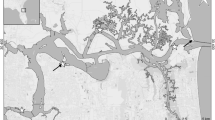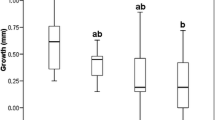Abstract
Biotic interactions such as predation may influence the success of invasive alien species (IAS). Although the Asian clam Corbicula fluminea is recognized as one of the most problematic aquatic IAS, few studies have investigated its use as a food resource. In this study, we aimed to investigate (i) the palatability of C. fluminea under natural (Minho River) and laboratory conditions and (ii) if C. fluminea submitted to different conditions (individuals from Lima and Minho Rivers) vary in palatability. Soft tissues from different Corbicula populations, plus soft tissues from a native clam, tuna and Corbicula shell powder were offered to consumers. Field assays were performed seasonally and laboratory assays only in summer; both assays also tested possible differences during distinct periods of the day. Overall, in natural conditions, the treatments containing C. fluminea had a low palatability. In laboratory assays, higher consumption (almost two times) was observed for Cyprinus carpio and Anguilla anguilla. Also, C. fluminea palatability was different between populations, with the treatment Corbicula Lima being more consumed than Corbicula Minho. Despite the low values of consumption in the field, laboratory results suggest that C. fluminea soft tissues can be a food resource to some species.




Similar content being viewed by others
References
Alofs, K. M. & D. A. Jackson, 2014. Meta-analysis suggests biotic resistance in freshwater environments is driven by consumption rather than competition. Ecology 95: 3259–3270.
Anderson, M. J., 2001. A new method for non-parametric multivariate analysis of variance. Austral Ecology 26: 32–46.
Anderson, M. J., R. N. Gorley & K. R. Clarke, 2008. PERMANOVA + for PRIMER: guide to software and statistical methods. Plymouth, PRIMER-E.
Araujo, R., D. Moreno & M. A. Ramos, 1993. The Asiatic clam Corbicula fluminea (Müller, 1774) (Bivalvia: Corbiculidae) in Europe. American Malacological Bulletin 10: 39–49.
Bolser, R. C. & M. E. Hay, 1996. Are tropical plants better defended? Palatability and defenses of temperate versus tropical seaweeds. Ecology 77(8): 2269–2286.
Bouchereau, J., C. Marques, P. Pereira, O. Guelorget, S. Lourié & Y. Vergne, 2009. Feeding behaviour of Anguilla anguilla and trophic resources in the Ingril Lagoon (Mediterranean, France). Cahiers de Biologie Marine 50: 319–322.
Carlsson, N. O. L., O. Sarnelle & D. L. Strayer, 2009. Native predators and exotic prey – an acquired taste? Frontiers in Ecology and the Environment 7(10): 525–532.
Carlsson, N. O. L., H. Bustamante, D. L. Strayer & M. L. Pace, 2011. Biotic resistance on the increase: native predators structure invasive zebra mussel populations. Freshwater Biology 56: 1630–1637.
Colautti, R. I., A. Ricciardi, I. A. Grigorovich & H. J. Maclsaac, 2004. Is invasion success explained by the enemy release hypothesis? Ecology Letters 7: 721–733.
Crespo, D., M. Dolbeth, S. Leston, R. Sousa & M. A. Pardal, 2015. Distribution of Corbicula fluminea in the invaded range: a geographic approach with notes on species traits variability. Biological Invasions 17: 2087–2101.
Dorn, N. J. & M. Hafsadi, 2016. Native crayfish consume more non-native than native apple snails. Biological Invasions 18: 159–167.
Ehrenfeld, J. G., 2010. Ecosystem consequences of biological invasions. Annual Review of Ecology, Evolution, and Systematics 41: 59–80.
Epifanio, R. A., D. L. Martins, R. Villaça & R. Gabriel, 1999. Chemical defenses against fish predation in three Brazilian octocorals: 11β, 12β epoxypukalide as a feeding deterrent in phyllogorgia dilatata. Journal of Chemical Ecology 25(10): 2255–2265.
Ford, S. D., 1996. Range extension by the oyster parasite Perkinsus marinus into northeastern United States: response to climate change? Journal of Shellfish Research 15: 45–56.
French, J. R. P. I. I. I., 1993. How well can fishes prey on zebra mussels in eastern North America? Fisheries 18: 13–19.
Gutiérrez, J. L., C. G. Jones & R. Sousa, 2014. Toward an integrated ecosystem perspective of invasive species impacts. Acta Oecologica 54: 131–138.
Huusko, A., L. Greeberg, M. Stickler, T. Linnansaari, M. Nykänen, T. Vehanen, S. Koljonen, P. Louhi & K. Alfredsen, 2007. Life in the ice lane: the winter ecology of streams Salmonids. River Research and Applications 23: 469–491.
Ibrahim, A. M., M. T. Khalil & M. F. Mobarak, 1995. On the feeding behavior of the exotic crayfish Procambarus clarkii in Egypt and its prospects in the biocontrol of local vector snails. Journal of Union of Arab Biologists Cairo 4: 321–340.
Ilarri, M. & R. Sousa, 2012. Corbicula fluminea Müller (Asian clam). In Francis, R. A. (ed.), A handbook of global freshwater invasive species. Earthscan, London: 173–183.
Ilarri, M. I., C. Antunes, L. Guilhermino & R. Sousa, 2011. Massive mortality of the Asian clam Corbicula fluminea in a highly invaded area. Biological Invasions 13(2): 277–280.
Ilarri, M. I., A. T. Souza, C. Antunes, L. Guilhermino & R. Sousa, 2014. Influence of the Asian clam Corbicula fluminea (Bivalvia: Corbiculidae) on estuarine epibenthic assemblages. Estuarine Coastal and Shelf Science 143: 12–19.
Ilarri, M. I., A. T. Souza & R. Sousa, 2015a. Contrasting decay rates of freshwater bivalves’ shells: aquatic versus terrestrial habitats. Limnologica 51: 8–14.
Ilarri, M. I., A. T. Souza, V. Modesto & R. Sousa, 2015b. Differences in the macrozoobenthic fauna colonizing empty bivalve shells before and after invasion by Corbicula fluminea. Marine and Freshwater Research 66(6): 549–558.
Ilhéu, M., J. M. Bernardo & S. Fernandes, 2007. Predation of invasive crayfish on aquatic vertebrates: the effect of Procambarus clarkii on fish assemblages in Mediterranean temporary streams. Biological Invaders in Inland 29: 543–558.
Keane, R. M. & M. J. Crawley, 2002. Exotic plant invasions and the enemy release hypothesis. Trends in Ecology and Evolution 17: 164–170.
Long, J. D., L. Porturas, E. Jones, C. Kwan & G. C. Trussell, 2013. Seaweed traits linked to wave exposure determine predator avoidance. Marine Ecology Progress Series 62: 175–183.
Lonsdale, W. M., 1999. Global patterns of plant invasions and the concept of invisibility. Ecology 80: 1522–1536.
Molloy, D., A. Karatayev, L. E. Burlakova, D. P. Kurandina & F. Laruelle, 1997. Natural enemies of zebra mussels: predators, parasites, and ecological competitors. Reviews in Fisheries Science 5: 27–97.
Mota, M., R. Sousa, A. Bio, J. Araújo, C. Braga & C. Antunes, 2014. Seasonal changes in fish assemblages in the River Minho tidal freshwater wetlands, NW of the Iberian Peninsula. Annales de Limnologie-International Journal of Limnology 50: 185–198.
Novais, A., A. Souza, M. Ilarri, C. Pascoal & R. Sousa, 2015a. From water to land: how an invasive clam may function as a resource pulse to terrestrial invertebrates. Science of the Total Environment 538: 664–671.
Novais, A., A. T. Souza, M. Ilarri & R. Sousa, 2015b. Facilitation in the low intertidal: effects of an invasive species on the structure of an estuarine macrozoobenthic assemblage. Marine Ecology Progress Series 522: 157–167.
Novais, A., A. Souza, M. Ilarri, C. Pascoal & R. Sousa, 2016a. Effects of the invasive clam Corbicula fluminea (Müller, 1774) on an estuarine microbial community. Science of the Total Environment 566–567: 1168–1175.
Novais, A., E. Dias & R. Sousa, 2016b. Inter-and intraspecific variation of carbon and nitrogen stable isotope ratios in freshwater bivalves. Hydrobiologia 765(1): 149–158.
Oliva, A., C. A. Ubeda, I. E. Vignes & A. Uriondo, 1981. Contribucíon al conocimento de la ecología alimentaria del bagre amarillo (Pimelodus maculatus Lacépède, 1803) del Río de la Plata (Pisces, Pimelodidae). Revista del Museo de Ciencias Naturales 1: 30–50.
Pawlik, J. R. & W. Fenical, 1992. Chemical defense of Pterogorgia anceps, a Caribbean gorgonian coral. Marine Ecology Progress Series 87: 183–188.
Peck, L. S., 1993. The tissues of articulate brachiopods and their value to predators. Philosophical transactions of the royal society B 339: 17–32.
Peck, L. S., 2001. Ecology of articulated brachiopods. In Carlson, S. J. & M. R. Sandy (eds), Brachiopods ancient and modern: a tribute to G. Arthur Cooper, 7. The Paleontological Society, New Haven: 171–183.
Pereira, L. J., S. Pinho, A. Ré, P. A. Costa, R. Costa, F. Gonçalves & B. B. Castro, 2016. Biological control of the invasive Asian clam, Corbicula fluminea: can predators tame the beast? Hydrobiologia 779: 209–226.
Robinson, J. V. & G. A. Wellborn, 1988. Ecological resistance to the invasion of a freshwater clam, Corbicula fluminea: fish predation effects. Oecologia 77: 445–452.
Simberloff, D., J. L. Martin, P. Genovesi, V. Maris, D. Wardle, J. Aronson, F. Courchamp, B. Galil, E. Garcia-Berthou, M. Pascal, P. Pyšek, R. Sousa, E. Tabacchi & M. Vilà, 2013. Impacts of biological invasions: what’s what and the way forward. Trends in Ecology and Evolution 28: 58–66.
Sousa, R., L. Guilhermino & C. Antunes, 2005. Molluscan fauna in the freshwater tidal area of the River Minho estuary, NW of Iberian Peninsula. Annales de Limnologi-International Journal of Limnology 41: 141–147.
Sousa, R., C. Antunes & L. Guilhermino, 2006. Factors influencing the occurrence and distribution of Corbicula fluminea (Müller, 1774) in the River Lima estuary. Annales de Limnologie-International Journal of Limnology 42: 165–171.
Sousa, R., A. J. A. Nogueira, M. B. Gaspar, C. Antunes & L. Guilhermino, 2008a. Growth and extremely high production of the non-indigenous invasive species Corbicula fluminea (Müller, 1774): possible implications for ecosystem functioning. Estuarine, Coastal and Shelf Science 80: 289–295.
Sousa, R., S. Dias, V. Freitas & C. Antunes, 2008b. Subtidal macrozoobenthic assemblages along the River Minho estuarine gradient (north-west Iberian Peninsula). Aquatic Conservation: Marine and Freshwater Ecosystems 18: 1063–1077.
Sousa, R., M. Rufino, M. Gaspar, C. Antunes & L. Guilhermino, 2008c. Abiotic impacts on spatial and temporal distribution of Corbicula fluminea (Müller, 1774) in the River Minho estuary, Portugal. Aquatic Conservation: Marine and Freshwater Ecosystems 18: 98–110.
Sousa, R., C. Antunes & L. Guilhermino, 2008d. Ecology of the invasive Asian clam Corbicula fluminea (Müller, 1774) in aquatic ecosystems: an overview. Annales Limnologia-International Journal of Limnology 44: 85–94.
Sousa, R., P. Morais, E. Dias & C. Antunes, 2011a. Biological invasions and ecosystem functioning: time to merge. Biological Invasions 13: 1055–1058.
Sousa, R., M. Ilarri, A. T. Souza, C. Antunes & L. Guilhermino, 2011b. Rapid decline of the greater European peaclam at the periphery of its distribution. Annales Limnologie-International Journal of Limnology 47: 211–219.
Sousa, R., F. Freitas, A. J. A. Nogueira, M. Mota & C. Antunes, 2013. Invasive dynamics of the crayfish Procambarus clarkii (Girard, 1852) at the international section of the River Minho (NW of the Iberian Peninsula). Aquatic Conservation: Marine and Freshwater Ecosystems 23: 656–666.
Strayer, D. L., 2012. Eight questions about invasions and ecosystem functioning. Ecology Letters 15: 1199–1210.
Tucker, J. K., F. A. Cronin, D. W. Soergel & C. H. Theiling, 1996. Predation on zebra mussels (Dreissena polymorpha) by common carp (Cyprinus carpio). Journal of Freshwater Ecology 11: 363–372.
Vilà, M., C. Basnou, P. Pyšek, M. Josefsson, P. Genovesi, S. Gollasch, W. Nentwig, S. Olenin, A. Roques, D. Roy, P. E. Hulme & DAISIE partners, 2010. How well do we understand the impacts of alien species on ecosystem services? A pan-European cross-taxa assessment. Frontiers in Ecology and the Environment 8: 135–144.
Wilhem, C. & M. Plummer, 2012. Diet of radiotracked musk turtles, Sternotherus odoratus, in a small urban stream. Herpetological Conservation and Biology 7: 258–264.
Acknowledgments
This study was conducted as part of the project FRESCHO: Multiple implications of invasive species on Freshwater Mussel coextinction processes, supported by FCT (contract: PTDC/AGRFOR/1627/2014). MI is supported by a Post-doc grant (SFRH/BPD/90088/2012) from the Portuguese Foundation for Science and Technology—FCT through POPH/FSE funds. RS also acknowledge the support of the strategic programme UID/BIA/04050/2013 (POCI-01-0145-FEDER-007569) funded by national funds through the FCT I.P and by the ERDF through the COMPETE2020—Programa Operacional Competitividade e Internacionalização (POCI). Special thanks to Allan Souza and two anonymous reviewers for valuable suggestions, and to Luís Amorim for helping in the field assays.
Author information
Authors and Affiliations
Corresponding author
Additional information
Guest editors: Manuel P. M. Lopes-Lima, Ronaldo G. Sousa, Lyuba E. Burlakova, Alexander Y. Karatayev & Knut Mehler / Ecology and Conservation of Freshwater Bivalves
P. S. Castro and M. I. Ilarri made equal contributions to this work.
Rights and permissions
About this article
Cite this article
Castro, P.S., Ilarri, M.I., Modesto, V. et al. Palatability of the Asian clam Corbicula fluminea (Müller 1774) in an invaded system. Hydrobiologia 810, 97–108 (2018). https://doi.org/10.1007/s10750-017-3136-0
Received:
Revised:
Accepted:
Published:
Issue Date:
DOI: https://doi.org/10.1007/s10750-017-3136-0




